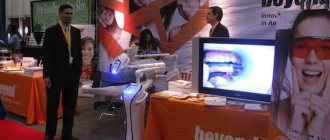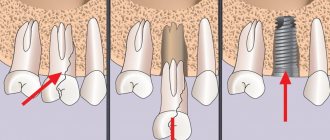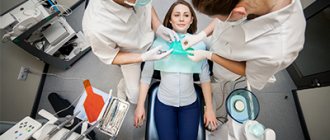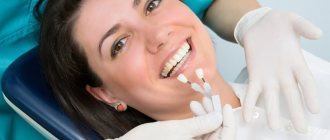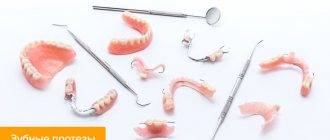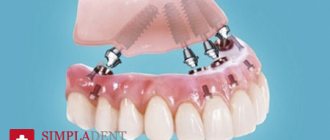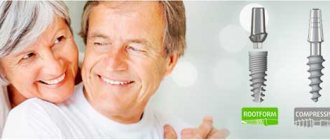The all on 4 method is implantation in the complete absence of teeth in the jaw, when a fixed bridge prosthesis is fixed to only 4 titanium supports. Prosthetics are performed no later than 72 hours after the implantation surgery, which allows patients to restore their teeth in record time.
The all on 4 technique is based on the unique properties of titanium. The metal is capable of merging with human bone tissue and forming a single, strong structure. The healing process is called osseointegration.
Nobel-Biocare, after further improvements to the titanium surface, achieved a uniquely rapid fusion of titanium and jaw bone tissue and in 1998 announced the all-on-4 protocol - “All on 4 implants”.
All-on-4: the essence of the protocol
The patient has 4 dental titanium implants surgically implanted into the bone tissue of the toothless jaw. Based on the casts, a permanent prosthesis is prepared, which is installed almost immediately. The first artificial jaw is temporary. It is worn for 5-36 months - it all depends on the design and material of the prosthesis. Then the orthopedic product is replaced with a new one, which the patient wears for decades.
Are there any complications after the procedure?
Among the possible complications, experts in the field of implantology highlight a fracture of the base of the prosthesis, which often happens when, after implantation of the implantological system, a temporary removable structure without metal is fixed. Other possible problems include inflammation of the gums immediately after surgery, loss of an artificial root due to an incorrectly selected place for its implantation or a poorly performed operation.
One of the most undesirable consequences is peri-implantitis - inflammation of the surrounding soft tissues that support the implant. If during the rehabilitation period there is an exacerbation of symptoms characteristic of inflammatory processes, you should immediately consult a doctor.
Implantation ol he 4: features of the technique
All on four - implantation with wide possibilities. Thanks to a simplified method of implantation and prosthetics, tens of thousands of patients were able to restore the natural functions of their teeth and a beautiful smile.
The all on 4 protocol is based on the use of only 4 dental implants. They are the basis of the system, its main advantage. But also the one-stage “all on 4” implantation method is:
- computer planning
— an implant surgeon evaluates bone tissue density based on CT and 3D modeling results, selects optimal points for implantation without harming nearby anatomically important structures;
- inclined installation of 2 lateral implants
— titanium screws are implanted into the distal parts of the jaw at an angle of 30-45 degrees, which increases the area of contact between artificial roots and bone tissue and guarantees uniform load distribution;
- direct installation of a second pair of implants in the anterior jaw
— stabilization of the system, increasing its strength and convenience for patients;
- use of Multi-Unit abutments
— a special adapter system compensates for the difference between the installation angle of the titanium rod and the denture, which allows the artificial jaw to be placed anatomically correctly and comfortably for the patient.
The importance of preparing for treatment
Any immediate loading protocol involves working in conditions of varying degrees of bone atrophy. That is why it is so important to conduct a thorough diagnosis of the patient in advance, make sure that he has no contraindications for implantation, and select the most suitable places for implantation and design models. You will definitely have to undergo cone beam tomography - this is a 3D image with a high degree of image detail. If zygomatic implants are to be implanted, you will need to undergo multi-slice tomography to obtain even more complete and detailed information about the clinical picture.
By the way, it is better to carry out such examinations in specialized diagnostic centers with the most modern professional equipment. Also, before treatment, you will have to pass all the necessary tests, undergo an examination by specialized doctors if necessary, heal the teeth remaining in the mouth and relieve inflammatory processes. Only after this can you proceed directly to treatment planning.
Advantages of All-on-4 implantation
Benefits of choosing the all on 4 implantation method in comparison with the two-stage traditional protocol:
- small number of installed implants
— only 4 for fixing a full jaw prosthesis versus 6-10 implants using classical technology;
- instant installation of a full-fledged fixed prosthesis
— there is no need to wait for the implants to take root and endure inconvenient removable structures;
- minimum surgical steps
— when prosthetics are performed on 4 implants, the implants are placed without bone grafting, and the two-stage protocol often requires additional bone tissue augmentation;
- optimal survival rate
— for the all-on-4 protocol, implants with survival rates of more than 92% are used, and modern technologies and the professionalism of doctors increase this parameter to 98-99%;
- treatment speed
— an experienced implantologist needs no more than 2-3 hours to implant all four implants and preliminary remove the patient’s teeth if necessary.
Dental implantation using the all on 4 method is also actively compared with removable prosthetics. The advantages of the one-step protocol in this case are undeniable:
- Simple hygiene - fixed dentures are cleaned like regular teeth, there are no special conditions for storage, rinsing, or care.
- Convenience and comfort of use - artificial teeth “All on 4” have titanium roots and are tightly fixed in the mouth. The denture does not fall out, does not rub the gums, and does not interfere with speaking. The all on 4 system completely replaces regular teeth.
- Simple adaptation - adaptation lasts literally a few days and is associated with the restoration of the sensations of a full set of teeth in the oral cavity.
- The taste of dishes is preserved - the basis of removable systems distorts taste perception; a fixed all-on-four prosthesis is completely free of this drawback.
All on 4: disadvantages
The negative aspects of the “all-on-fo” protocol are very conditional:
- Contraindications
. There are limitations in any implantation option, but a thorough examination and a competent doctor help reduce the risks. In critical cases, the implantologist selects an alternative option for comfortable prosthetics.
- High demands on the professionalism of a doctor
. The all on 4 technique requires careful calculations, mastery of surgical techniques, and a competent assessment of any emerging situation. It’s easy to find a good implantologist who specializes in the “all-on-4” protocol based on doctor ratings.
- Loose bone tissue in a patient
. For the upper jaw, the problem is solved by selecting Nobel Zygoma zygomatic dental implants; for the lower jaw, by accurately calculating the time of all on 4 prosthetics.
Maintenance and care of the prosthesis –
Permanent dentures All-on-4 require a very careful attitude. If you previously had a regular removable denture and cleaning it from plaque and food debris was quite simple, now your time spent on hygiene will immediately increase several times. Unfortunately, this comes at a price for the opportunity to have completely permanent dentures. The biggest difficulty is cleaning the underside of the denture.
A fixed denture does not “lie” on the gums, and between the gum and the lower surface of the denture there will be a rinsing space - where food debris will certainly fall. And, accordingly, with insufficient hygiene, plaque and tartar will be deposited on the lower surface of the denture. To prevent this, it will be necessary to regularly use an oral irrigator, as well as use special super-flosses. In addition, regular cleaning of the denture with a soft toothbrush will be required.
Professional denture maintenance – approximately once every 6 months you will have to visit the dental clinic for a professional cleaning session of the denture (for patients with poor hygiene – once every 3 months). To do this, the screws that secure the bridge to the implants are unscrewed, and the prosthesis is removed from the mouth. The lower surface of the prosthesis is professionally cleaned and polished, and then the prosthesis is again fixed to the implants using screws.
An important point is that the quality of hygiene of the lower surface of the prosthesis will depend not only on your efforts. When making a denture, a dental technician may make mistakes that may not allow the patient to clean the lower surface of the denture at all. Normally, the lower surface of the prosthesis should have a convex shape, but very often we see that the lower surface of the prosthesis is given a concave shape (Fig. 24-25) - it becomes impossible to clean such a surface with floss.
Therefore, patients with a concave shape of the lower surface of the prosthesis always have a large amount of tartar on the prosthesis, always have bad breath, as well as inflammation around the implants, which over time can lead to failure of all implants. But let's see what else you need. Patients with titanium-polymer dentures will have to replace artificial teeth in the denture approximately once every 7 years. The fact is that teeth made of acrylic plastic or ceramic composite gradually wear out (this happens especially strongly in the chewing areas).
Wearing of the chewing teeth will lead to a decrease in the height of the bite in the chewing sections and, accordingly, to an increase in the chewing load on the front teeth (which sooner or later will not withstand the load and will break).
Prosthetics using the all on 4 system: who is it suitable for?
Photos of teeth “all on 4 implants” can be seen in different patients. This indicates the versatility of the technique and its wide popularity. The concept solves many dental and aesthetic problems of patients - radically, once and for all. All-on-4 can only be performed if there is a sufficient amount of jaw bone tissue. If there is severe atrophy or bone deficiency, the doctor will suggest alternative options.
All on 4 dental implantation technology is indicated if:
- completely edentulous
- all teeth are missing on one or even both jaws;
- partial edentia
— many teeth in the upper or lower jaw are missing, and the remaining ones must be removed due to mobility or disease;
- intolerance to removable dentures
- discomfort, gag reflex, allergic reaction to artificial teeth materials;
- contraindications to bone grafting
— bone augmentation is not possible for medical reasons.
Also, the all on 4 concept attracts patients who choose an economical and reliable implantation option for themselves. In this case, the issue is resolved directly with the implant surgeon. The doctor assesses the condition of problem teeth, conducts diagnostics, and decides on the possibility of implanting four titanium pins to install a fixed prosthesis.
All on 4 implants, if there are accompanying indications, are suitable for almost all patients who do not smoke, do not have serious diagnoses or dysfunctions of the endocrine and cardiovascular systems and monitor their oral health. If all this is present, the “all on four” protocol will be allowed for use.
Prices and reviews for all-on-4 dentures are very attractive. And more and more patients are interested in the all on 4 technique, seeking to restore a full set of teeth before truly serious problems arise with the gums and bone tissue.
Features of choosing implants
To carry out implantation using the four-way system, products (Nobel), which developed this method, are most often used. Moreover, in each individual case, implants are selected individually for each patient. According to reviews from patients and specialists, Zygoma models are often added to the complex. These are elongated structures that are used during the development of atrophic processes in the upper jaw. The special shape makes it possible to minimize the risk of injury to the maxillary sinus. They are fixed in the zygomatic bone.
Zygoma implants are fixed in the cheekbones
On a note! This manufacturer produces quite expensive, but high-quality products. You can save a little on treatment by giving preference to implants from other, more budget-friendly, but no less reliable brands, for example Alpha Dent (Germany) or Osstem (South Korea). True, here you still have to give up the immediate load, that is, agree to wear a removable denture for at least six months without support from implants, because structures are simply not provided to withstand the load from the prosthesis. Of course, the doctor may insist otherwise - but be careful: even if nothing happens right away, after a few years the implants may simply fail. That is, the savings will, on the contrary, result in increased costs for you to redo the entire operation.
Single-stage implantation all on four: stages of prosthetics
Dental implants can be inserted in Moscow on a turnkey basis at different prices. In most cases, the cost is influenced by the volume of work performed, the type of dental implants, the experience and demand of the doctor. Dental clinics offer ready-made packages of services, which may differ significantly from each other. In order not to make a mistake and subsequently pay extra for important examinations and manipulations, the patient must know the stages of the “all on four” protocol.
All on 4 prosthesis: photos and features of ceramic composite
Usually there are only three main steps of all on 4 implantation:
- Preparatory.
- Surgical.
- Orthopedic.
In fact, the correct all-on-fo implantation protocol consists of six steps:
- Preparation, diagnostics.
- Implantation.
- Installation of an adaptive fixed prosthesis.
- Rehabilitation after surgery.
- Hygienic stage.
- Replacing a temporary denture with a permanent one.
Prices and promotions for dental implantation in Moscow directly depend on what stages of all on 4 the dental clinic takes into account, so it is worth considering the treatment in as much detail as possible.
Preparation for all-on-4 implantation surgery
The preparatory stage begins with diagnosis. Without an examination, no doctor will recommend implantation or select an implant manufacturer.
Examinations are necessary to exclude contraindications and plan treatment. Usual appointments for the patient:
- OPTG
— panoramic photo;
- CT
— 3D model, computed tomography result;
- standard set of analyzes - UAC
,
OAM
,
blood biochemistry.
If necessary or if there are certain diagnoses, the implantologist will refer the patient to a specialist for permission, an ECG and additional examinations. The decision is made individually according to the collected medical history.
In the photographs, the doctor will look at the volume and structure of the bone tissue of the jaws. This will be followed by computer planning, calculation of implantation points, and in some cases, production of a surgical template.
Simultaneously with building a treatment strategy, the doctor assesses the risks and gives prognoses for all-on-4 implantation. The result directly depends on the volume of preserved bone tissue - the more, the better. Experienced doctors know that ideal implant healing is guaranteed if:
- width of the alveolar ridge of the jaw - from 5 mm;
- the height of the bone tissue at the implantation point is 10 mm.
If the tests are good, the doctor agrees with the patient on the date of the operation and sends him to take impressions of the teeth, which will later serve as the basis for the manufacture of a denture.
All on 4 surgical protocol
The implementation of this stage depends on two points - the anesthesia chosen by the patient and the presence of teeth in the jaw.
Implantation is an unpleasant but fairly painless procedure, so it is usually performed under local anesthesia. However, the patient can choose to have all-on-4 implanted under sedation or anesthesia—in a state of drug-induced sleep. Artificial sleep makes the treatment unnoticeable and quick, eliminating anxiety and nervousness. Treatment during sleep is recommended for patients with dental phobia or other indications. The rest tolerate the procedure well under local anesthesia.
The presence of teeth in the jaw obliges the doctor to remove the remaining units before implantation. Then the surgeon immediately proceeds to installing artificial roots, implanting them at pre-planned points at precise angles.
Prices and reviews of all on 4 technology often lead to patients having both jaws restored at once. This can be done at one time, but the duration of the operation increases slightly. The effectiveness of such treatment is much higher than sequential implantation, since upon completion of all stages the patient becomes the owner of a full bite - two jaws with beautiful, even teeth.
Installation of a temporary adaptive prosthesis
While the surgical stage is underway or after it, a temporary adaptive fixed prosthesis is made for the patient in a dental laboratory. There are many requirements placed on him, as he must:
- completely replace the patient’s teeth until a permanent structure is installed;
- ensure normal, but not excessive load on implants and bone tissue - for rapid engraftment of artificial titanium roots;
- be comfortable, aesthetic, functional.
Temporary teeth are made of acrylic plastic with or without a metal frame. The presence of a beam determines the cost of the orthopedic structure, its durability and reliability. The metal base also affects the timing of fixation of the prosthesis on dental implants - immediately or after a few days.
The difference between the products is obvious:
Temporary denture without frame
- It is given to the patient directly on the day of all-on-4 implantation surgery.
- The operating life of the system is moderate - up to six months with mandatory replacement with a permanent option.
- The main advantage of the model is the price.
- The main disadvantages are fragility, high risk of breakage.
- The frameless option is not suitable for patients with bruxism or increased tone of the masticatory muscles.
Adaptive dental frame prosthesis
- Fixation on implants is performed 2-3 days after surgery, since dental technicians take longer to produce this orthopedic product.
- The metal frame guarantees the durability of artificial teeth - up to 2-3 years of trouble-free wearing.
- Advantages: durability, reliability, removal of all dietary restrictions.
- The disadvantage is the price.
Postoperative stage: recovery, recommendations
The all-on-4 surgical stage is almost always successful, but even an ideal operation requires follow-up monitoring by a doctor.
Patients are recommended:
- come for examination 1-2 times over the next 10 days - assess the condition of the gums, remove sutures, check the quality of healing;
- Gradually load the implants - eat moderately hard foods, slowly increase the chewing load.
Also, after implantation according to the all-on-4 protocol, the patient is required to follow the mandatory postoperative instructions:
- gentle brushing of teeth - using dental floss and mouthwash;
- calm rhythm of life - rest for the first 3-5 days after implantation;
- giving up smoking and alcohol - otherwise there may be difficulties with the implantation and general well-being.
Professional hygiene of an adaptive prosthesis
This stage is required for all temporary frame prostheses with a long wearing period. Its essence is professional cleaning and polishing of orthopedic structures in dentistry every six months. To do this, the doctor unscrews the 4 screws that secure the product to the implants, removes the denture and puts it in order. Then he fixes the artificial teeth back onto the implants.
Maintenance of the temporary structure by many clinics is included in the cost of turnkey all-on-4 implantation, but sometimes this is a separately paid procedure. To avoid incidents and unnecessary expenses, it is worth clarifying this point in advance.
Permanent prosthetics with all-on-fo implantation
After the implants have healed and the service life of the adaptive prosthesis has expired, the design is replaced with a permanent product. The patient himself chooses what exactly he will wear - based on material, price, aesthetics.
All-on-4 implantation is always the installation of an artificial jaw on 10-12 teeth, which is enough to ensure a beautiful smile and complete restoration of chewing functions. Larger structures for 12-14 teeth require 6 dental implants to be firmly fixed using the all-on-6 protocol.
Surgical templates do not help, but distort the picture when installing implants
Some doctors try to portray the use of surgical guides as a disadvantage. Arguing this is that such a landmark cannot be fixed, because bone atrophy manifests itself unevenly, which means there is a risk of installing an implant outside the desired area. If we are talking about standard guide templates, then this is indeed the case - but this was only the first step 10-15 years ago towards minimizing doctor errors.
Today, the development of digital technologies and robotic equipment makes it possible to create individual templates for each patient. Moreover, there are intraoral navigation systems for surgical procedures (GPS for the implantologist during surgery).
MYTH
When using a surgical template, there is a risk of installing an implant in an area with insufficient bone tissue. There is also a high probability of perforation of the bottom of the maxillary sinus in the upper jaw or damage to the mandibular nerve.
IS IT TRUE
Individual surgical templates are created precisely to protect the doctor and patient from damage to important organs and nerves, as well as to ensure accurate positioning in the bone according to a detailed plan on a 3D model of the jaw before surgery.
After careful planning of the “implant-prosthesis” design, several files are exported from NobelClinician, one of which is a task for a 3D printer to print an individual surgical template according to the data of the developed plan! The template takes into account the shape of the gingival margin, fits tightly to the mucosa, repeating the bends of the alveolar ridge. The templates are fixed on the jaw during surgery, which prevents their displacement. That is, if the process is carefully worked out in 3D, the likelihood of placing implants differently than intended is minimized. Only minor adjustments are possible in cases where the affected teeth are removed simultaneously with the installation of implants.
MYTH
Correct installation of implants can only be based on the results of 3D tomography (CT) of the jaw - this way the doctor can act more flexibly in the oral cavity, selecting areas with maximum volume and density of the jaw bone.
IS IT TRUE
Here it is worth asking a reasonable question - “how then does the doctor transfer the exact parameters of CT or 3D tomography into the oral cavity during surgery?” That's right - by eye and touch, without precise calculation. The conclusion is obvious - this is already the last century, because without accurate computer modeling of the implant treatment process there is a risk of making mistakes and losing the entire result.
So, as soon as you hear a doctor say that the use of surgical templates is a clear disadvantage, you can immediately and safely question his professionalism. Such a statement means that the doctor is distant and not even familiar with the original technology. I have never encountered the development of an individual template in practice, does not work in special software for treatment planning, and does not have special equipment for printing templates. You should be wary of his approach to installing implants - it can be dangerous: first of all, the loss of your health.
From the point of view of logic and translation of such a situation into ordinary life: which tailor would you prefer - the one who will sew according to an individual pattern, checking all the measurements several times, or the one who will simply estimate it by eye? Agree that there are few such talented geniuses, and we are dealing with health and your smile.
MYTH
When using a template, the proportion of trauma from surgery is greater, since it is necessary to peel off the gum flap to work with the bone.
IS IT TRUE
Surgical templates were created precisely to reduce the level of surgical intervention. They allow the implants to be positioned using the puncture method, without massive peeling of the flap, since the operation is planned in advance.
“The use of surgical templates simultaneously with 3D modeling of the implantation process makes the implantation result predictable. We do not work blindly, but have clear data on how to install implants, without injuring the sinuses or nerve endings, with the further possibility of performing high-quality prosthetics. This is a unified system and an integrated approach, and for the patient – the result that he initially expected.”
Bespalov Roman Dmitrievich, maxillofacial surgeon, implantologist, work experience of more than 26 years make an appointment
We learned from the best! Our doctors were trained by the developers of “all-on-four” implantation and visited the clinic of Dr. Paulo Malo, the founder of the method, in Portugal. We know exactly how to solve your problem with a guaranteed result using the original method!
Enroll now
Implants for 4: what the prosthesis looks like - materials
In the photo, the dentures on 4 implants look different. Some are natural, like real teeth, others are simpler. Main materials used in prosthetics:
- metal ceramics;
- zirconium dioxide;
- ceramic composite.
What are the global differences between artificial jaws made of different materials - pros and cons, characteristics.
Metal ceramics for all-on-4 prosthetics
Metal-ceramics is familiar to everyone who has ever thought about inserting a tooth on a turnkey basis.
This is the most inexpensive and aesthetic material in orthopedic dentistry. It is chosen for single prosthetics with crowns and for the manufacture of a full-fledged artificial jaw. Advantages of metal ceramics for all-on-4 prosthesis:
- Excellent physical and mechanical properties.
Cobalt chromium alloy is used as a metal component. It is characterized by high resistance to deformation, strength, and reliability. - Quite a long service life
- dentures made of metal ceramics last up to 10 years. - Affordable cost
- in comparison with zirconium crowns, the cost of the orthopedic stage will be 1.5-2 times lower.
Metal-ceramics also have disadvantages:
- risk of developing allergic or galvanic reactions;
- slightly unnatural appearance, poor aesthetics;
- If repairs are necessary, the entire prosthesis must be removed for restoration in the laboratory.
Zirconium metal-free permanent all on 4 design
Metal-free orthopedic structures are indistinguishable from real teeth.
They not only reliably imitate crowns and enamel, but also form an ideal gum contour for “all-on-4” prosthetics. Advantages of zirconium products:
- Aesthetics and believability
. No one will be able to distinguish artificial zirconium teeth from real ones. - Mechanical strength
. Higher than that of metal-ceramic prostheses, which guarantees the reliability and integrity of the system when worn. - Biocompatibility with human tissues
. The material does not cause allergic reactions or gum irritation. Due to the absence of metal in the crowns, the risk of galvanization is eliminated. - Durability of wearing
. Zirconium dioxide is inert to food dyes and odors, does not deform or collapse, and lasts for decades without repair or replacement.
Disadvantages of the all-on-4 zirconia prosthesis:
- High price.
All on 4 prosthesis: photos and features of ceramic composite
Ceramic-composite dentures are used quite often for all-on-4 implantation.
The reasons are simple:
- Ideal aesthetics of real teeth
. Layer-by-layer application of polymer during the manufacture of a prosthesis ensures the natural color of the enamel and natural light transmission. - Resistant to food coloring
. There is no need for even the slightest restrictions after installing teeth using the “all on 4” protocol. - Strength, reliability
. Ceramic composite has a low level of wear. - Convenient, quick repair without removing dentures
. Any chip can be easily restored using ceramic composite material.
Flaws:
- The high price of a titanium-based prosthesis - especially if premium segment implants are chosen for all-on-4.
- Careful daily care - good oral hygiene using a irrigator to eliminate the risk of plaque forming from inside the crowns.
Probability of complications
Prosthetics on 4 implants involves the stage of surgical intervention, and this is always inextricably linked with a certain risk of complications. True, in the case of one-stage technologies, this probability is reduced to a very minimum. Careful 3D planning of each individual stage allows you to take into account the slightest nuances and select the most suitable places for implants, eliminating any errors or inaccuracies. The use of surgical templates virtually eliminates the risk of incorrect positioning of structures.
In rare cases, there is a risk of fracture of the base of the prosthesis, however, with permanent prosthetics, such a nuisance is excluded. In other situations, the development of mucositis and peri-implantitis is possible - these are the most serious complications after implantation, which are characterized by acute signs of inflammation and infection of the tissues surrounding the implant. If after the operation the pain only increases, and in the area of the implanted structure the soft tissues noticeably redden, swell, bleed or even fester, you should urgently see a doctor.
Such a nuisance is possible both due to the fault of the specialist, due to his failure to comply with the implantation technique, and due to the patient’s negligence in caring for new teeth in the postoperative period. That is why it is so important to strictly adhere to all the recommendations of the attending physician and not to miss taking the medications prescribed by him - antibiotics, antiseptics and painkillers.
All on 4 or all on 6: what are the differences
The all-on-four protocol is recommended for patients with complete or partial edentia. In this case, some atrophy of bone tissue is acceptable - weak or moderate. If there is not enough bone material to stabilize the implants, then the doctor will consider a similar protocol with an increased number of implanted artificial roots - all-on-6.
This is an improved technique that involves the installation of 6 dental implants. The standard scheme is the implantation of implants in the tooth position 6-4-2|2-4-6. This guarantees uniform load on the bone, high primary stability of the system, and strength of fixation. It also allows the use of dentures with an increased number of crowns.
When restoring the upper jaw, doctors often use extended zygomatic implants. This helps to bypass anatomically dangerous areas and ignore atrophied bone tissue.
Features and benefits of the technology
- the optimal solution for complete restoration of the jaw – one or both at once,
- quick results - treatment takes no more than a week,
- high aesthetics of the final result - the prosthesis is equipped with acrylic gum, designed to hide defects in the edge of the mucous membrane. The adaptive design has lightweight plastic or ceramic-composite crowns - the latter are more reliable and durable and do not require re-prosthetics. After osseointegration of the titanium roots (after six months or a year), it is possible to install a stronger and more durable prosthesis, and even replace the material of the crowns - for example, with ceramic composite or zirconium dioxide. However, you can also use inexpensive plastic, but the service life will be shorter,
- refusal to build up atrophied areas of bone - inclined installation of lateral implants or the use of zygomatic models allows treatment in conditions of bone tissue atrophy without the need for its preliminary build-up. If resorption is very pronounced in the upper jaw, standard lateral implants are replaced with zygomatic ones, and they are attached to denser and sterile parts of the cranial bone, namely, in the zygomatic bone, as the name implies,
- rapid tissue restoration - occurs due to the compression effect, that is, compaction of the thickness of the bone tissue at the time of screwing in the implant (with a minimally invasive method of installing structures). In any case, the immediate installation of a prosthetic structure allows you to quickly normalize nutrition, restore chewing function, and provide the necessary load to activate metabolic processes in atrophied areas of the bone. All this contributes to faster and better engraftment of artificial roots. In addition, the stabilizing beam under the prosthesis connects the implants together and does not allow them to move,
- the possibility of minimally invasive installation - the use of special surgical templates made it possible to carry out such operations not in a flap, but in a less traumatic way. An elastic stencil with slits for the implantation sites is placed on the gum, after which punctures are formed in the mucosa and bone, through which the rods are screwed into the bone. Surgical templates are developed using computer simulation, which minimizes any risk of deviation from the norm,
- possibility of adjusting the prosthesis - the orthopedic device is fixed with a screw. This means that the structure is attached using small screws that pass through the chewing surface of the teeth. Therefore, the prosthesis can always be removed for relining, but this can only be done by the attending physician,
- choice of prosthetic options - immediately after implantation, a simple prosthesis on a metal beam and with plastic crowns can be installed. There is also the option of installing a more expensive, but reliable and high-quality structure with ceramic composite crowns and an individual titanium beam,
- rejuvenation effect - the prosthesis is fixed immediately, which contributes to the rapid restoration of the chewing and facial muscles, returns them to tone and helps fight wrinkles around the mouth, which often appear due to missing teeth.
How much does it cost to install a dental implant in Moscow on a turnkey basis: full price of the service
You can get teeth placed on implants in Moscow at different prices. The promotional price starts from 140 thousand rubles for one jaw and includes all basic services. The minimum price is focused on the use of budget OSSTEM or Implantium implants with survival rates of 92-95%.
Maximum success is guaranteed by premium brands - Straumann and Nobel Biocare, but the price using implants from these manufacturers increases by 2-2.5 times.
Regular turnkey package:
- free consultation;
- surgical stage for installation of 4 implants;
- orthopedic stage - installation of a standard denture.
All other services must be negotiated additionally - as part of the offered package or at an additional cost.
Timing of dental prosthetics
Temporary dentures
Immediately after implantation (on days 1-3), the patient is fitted with a temporary acrylic prosthesis with artificial gum. Chewing function is immediately restored, but the load should be increased gradually.
Artificial gum hides defects in the gingival contour. Crowns made of medical plastic allow adjustments to be made when the bite changes during the healing of implants, without removing the prosthesis.
Functions of an adaptive prosthesis:
- instantly restores aesthetics;
- splints implants for additional stability by combining them into one system;
- restores chewing function with a gradual increase in load;
- normalizes diction;
- ensures distribution and transmission of chewing load to bone tissue, accelerating osseointegration;
- corrects the correct bite;
- function from several months to 2 years.
Permanent structures
The adaptation prosthesis is replaced with a permanent one no earlier than 4 months after implantation, when the osseointegration process is completed. Permanent structures are more aesthetically pleasing and can withstand increased chewing loads. Fixed with screws or cement.
Differences from temporary dentures:
- the base has a titanium arc, which adds reliability;
- artificial gum may be absent if the gingival contour has formed;
- crowns are more durable - made of acrylic on a frame, ceramic composite, metal-plastic, metal-ceramics, zirconium dioxide;
- have been in operation for 10 years.
All on 4 implantation: what’s the catch with the low price
When figuring out how much it costs to insert a dental implant in Moscow, many patients pay attention to unrealistically low prices. What is the catch with cheap services and what you need to pay attention to when choosing all on 4 implantation in metropolitan clinics:
- Savings on prosthesis and implantation components
.
A dental implant is usually a prefabricated structure that directly includes a titanium screw and an abutment adapter. The product is loaded with a denture on top. Saving on abutments and prosthetics reduces the cost of “all-on-four” implantation, but poses risks later. Potential problems include numerous corrections, broken abutments, frequent repairs of dentures, allergies to the material, staining of crowns.
- Inexpensive implants
.
Ratings of dental implants introduce patients to numerous series of different price ranges. But the all-on-4 protocol was created exclusively for Nobel Biocare. Today, series of all premium brands, products of the South Korean company OSSTEM, and the Dentium Implantium line are adapted to the “all on 4” concept. All other implants are a risk for the patient.
- Partial provision of services
.
To increase the attractiveness of all-on-4 implantation, many clinics indicate the price not “turnkey”, but for one stage - usually for dental surgery. The patient pays for everything else independently. The risk of such a situation can be reduced by clarifying the specific services in the package and carefully studying the contract, which specifies the fixed final price and its components.
- Inexperienced doctors
.
To reduce prices and attract patients, a number of clinics invite young implantologists. The patient saves, and the doctors learn to do quality work. Participation in such a “project” is a lottery with rare winnings.
Having decided to take care of your own health, you should not save on all-on-4 implantation. The consequences and risks are much more serious than they initially seem.
Alternative solutions
- on six: this technique is widely used for moderate degrees of bone tissue atrophy. The use of this number of implants instead of four allows for reliable fixation of the orthopedic structure,
Implantation according to the All-an-6 protocol - basal protocol: the optimal solution to the problem of complete edentia. In this case, up to 12 implants are installed, which are fixed in the deep layers of bone tissue, protected from atrophy. This method is relevant for situations where the bone volume is very small.
But you shouldn’t even consider classical implantation if you need to restore all the teeth in a row. There is not enough bone for implants, and extension is not possible. This is very difficult (for such a volume) and expensive.
Alternatives to all-on-4 implantation
The most popular alternative to all-on-4 implantation is the all-on-6 protocol. A larger number of implants, stability and also a fairly favorable price. But it happens that both concepts are not suitable for patients - for financial or other reasons.
Then the dental clinic offers alternative solutions for the complete restoration of the dentofacial line:
- Fixed dental bridge
. For strong fixation, it requires the presence of supporting healthy teeth and can sufficiently replace missing units externally and functionally.
- Removable dental prosthesis
. It has virtually no contraindications and is very inexpensive. But even one made from the most modern materials differs from all-on-4 implantation in increased discomfort in wearing and maintenance. Increases the risk of rapid bone tissue atrophy.
- Prosthesis on 6-10 implants
. The doctor uses a classic two-stage implantation protocol. The patient needs to be prepared for significant expenses and long-term wearing of a removable denture. The permanent structure will be installed only after the artificial titanium roots have completely engrafted.
- Basal implantation
. A special feature of the technique is the use of implants that reach the basal bone during installation. The basal bone is dense, not prone to atrophy, and supports implants well. The method is recommended for smokers, as well as for patients with diabetes.
All-on-4 implantation guarantees a full mouth of teeth in the shortest possible time. A safe, comfortable method of treating adentia and other dental problems. You can select a clinic for a profitable operation with a promotion and an experienced implant surgeon in the corresponding ratings on the 1dentist website.
New standard of implantation – minimal invasiveness
The world does not stand still; new research is constantly being conducted in the field of dental implantation. Long-term 10- and 20-year observations of implants functioning successfully in the oral cavity are appearing. Clinical studies show that the thickness and length of the titanium rod are not the main factor in success. Implants of large diameter and length often lead to complications and their lifespan is sometimes shorter. This is due, first of all, to the more traumatic installation of “thick” models.
An important factor in the long-term functioning of artificial roots is the preservation of the patient's own bone through the use of thinner and shorter implants. This also reduces the need for bone grafting because Initially, less bone tissue is needed to completely immerse a thin implant into the bone.
However, thin models from not all manufacturers are able to withstand heavy loads in the area of chewing teeth, or in the absence of teeth. These requirements are met by German Ankylos implants
, as well as Swiss Straumann Roxolid implants.
Ankylos implants have design features that, when installed below the level of bone tissue, allow them to withstand heavy loads even with their small diameter. Roxolid is an alloy of titanium and zirconium, which was developed by Straumann. It is much stronger than just titanium and has the same biocompatibility. Therefore, thin Straumann Roxolid implants can be used in cases where it is necessary to install a larger titanium pin from another manufacturer.
- Minimal invasiveness.
- No bone grafting required.
- Guaranteed results even in complex clinical cases.
Stages
- Preparation . The patient undergoes clinical and radiological examination. The implantologist selects a treatment protocol and plans the operation using computer modeling.
- Implantation. The surgical intervention, during which 4 implants are installed in the jaw, takes up to 3 hours. It is performed under local anesthesia, sedation or general anesthesia.
- Temporary prosthetics . The patient is fitted with an adaptive prosthesis immediately after implantation or within 72 hours.
- Permanent prosthetics . After a minimum of 4 months, the adaptation prosthesis is replaced with a permanent one.
All teeth in one day
This type of procedure, also known as “teeth in a day” or instant implantation, is an innovative system designed to give you a completely new and natural-looking smile in one visit to the dentist.
Varieties
Sign up for a consultation with our specialists in Moscow. We successfully install several types of prostheses:
- Acrylic - an aesthetic and economical option, using pink plastic and three-layer teeth;
- Metal-ceramic - a prosthesis with a high level of strength due to the titanium base and ceramic-composite facing part;
- Metal-free – the design is lightweight and physiological. Thanks to the BioHPP material, a high level of aesthetics is achieved.
The final cost is also influenced by the amount of treatment required (tooth extraction, caries elimination) before surgery and the type of prosthetic materials.
